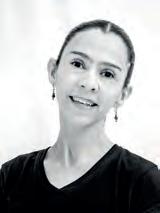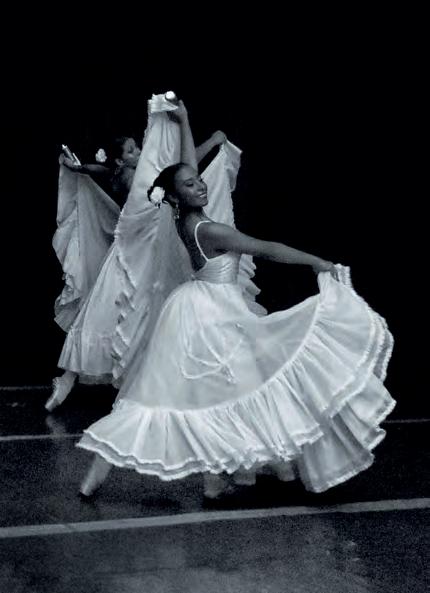
6 minute read
Dance careers in the Americas
ISTD International Representative, Astrid Sherman, speaks to three of our members about why a foundation of ISTD training helps inspiration to flourish around the world.
When I ran a school in Canada, I often found myself explaining to parents the value of ISTD training. They questioned the additional costs for examinations when other schools just offered open classes.
• Every examination, with its certification, is validated, which is proof of standards attained.
• Every examination attained shows a higher level of commitment from both student and teacher.
• Our examinations offer achievable goals with defined progression and stimulate tenaciousness, curiosity, and commitment in students who will apply these lessons in all future endeavors.
• Even though the accreditation is not yet internationally direct for all schools and university credits as it is in the UK, certain schools allow for Arts, Education or PE credits (level dependent), or some sort of career-life connection (a course that is designed to identify and develop each student’s personal interests, passions and goals) and capstone project (final year project) credit with proof of vetted examinations.
• Students who completed vocational examinations are good candidates for PhD and Doctorate programme selection committees as they demonstrate the commitment to stay the course and have interests outside of academics for life balance.
• Proof of ISTD Accreditation when immigrating gives extra certified credentials for work purposes/employment opportunities.
Three ISTD alumni in my area are ideal examples of the influence and inspiration that a foundational ISTD training can have globally.
Erika Mayall
Owner and physiotherapist, Allegro Performance Clinic, Vancouver, Canada

During the years when Erika was training in ISTD Modern, Tap and Imperial Ballet, she realised there was a lack of professionals specifically experienced in treating dancers. This sparked her interest in a career in physiotherapy, and more specifically in a career in dance physiotherapy.
Erika says that as a dance physiotherapist, she spends a lot of time assessing and analysing movement quality and dance technique. “The majority of overuse injuries in dance come from faulty biomechanics or incorrect dance technique. Being able to identify these faults and address the root cause is critical in the treatment process. My training in ISTD helped me to develop these skills, and understanding the technical progressions within the syllabus system allows me to ensure that dancers are meeting technical requirements as they progress through their treatment and training.”
She also says that ‘knowing’ the vocabulary and being able to ‘speak the language’ of dance also helps her to communicate effectively, not just with her clients, but also with their dance teachers. This collaborative approach she says, ensures the dancers’ health and wellness is always a priority, and that things worked on in the clinic can also be addressed in the studio setting. Erika also can often be found giving studio workshops in injury prevention and pointe readiness to young students.
Richard Ambrose
Performer and choreographer, Saint Lucia, Caribbeans

Richard began ISTD syllabus work with the Saint Lucia School of Ballet & Modern Dance under director Theresa LowrieCollymore. He later excelled at the Schoerer School in Guadeloupe before proceeding to dance studies at the St Denis University Paris VIII in France. Richard has performed and choreographed in the Caribbean, the US, Europe and Africa. His work has qualified for the 2023 Francophonie Olympic games in Kinshasa. This contemporary Caribbean piece, Belelesh, explores issues of male identity.
In Saint Lucia, Richard engages in several climate justice and social awareness efforts. He combines sensitivity, technique and art, making poignant statements that he hopes “can spark some change”. He can be seen in a visual classical music album, experimental YouTube video concept by English pianist Fabio D’Andrea, featuring his picturesque homeland.
Internationally, Richard has collaborated with Le Plus Petit Cirque du Monde and La Ruche theatre company. ‘Spectacle vivant’ or live art performance allows him to reach, build and motivate throughout the Caribbean especially. His formal training in dance, married to the rites, traditional dance knowledge and research that he engages in, educates his work and adds a formidable newness with authenticity. To herald Saint Lucia’s two Nobel laureates, Richard is now exploring the signature Gros Islet Friday Night Street Party in his hometown. He aims to use the phenomenon as impetus for his new indigenous-based artistic work.
“The ISTD was an affirmation for me. It sparked a greater conversation on movement, and how to process and speak intelligently about dance. I now analyse movement, recognising it can employ a jargon that is precise – identifying rudiments and principles in our dance forms.”
Frida Bader Villarreal Yosif
Artistic Director, Coppelia’s Ballet and Company, Playa Del Carmen, Mexico

For Frida, the Imperial Classical Ballet has been very important in her development as a teacher and director for her school and company. Frida says that in Mexico it is beneficial to have a school that offers official training which gives documentation of accreditation that supports any dance studies. Thus, when she first opened her school, despite her background in the Cuban method, she retrained in ISTD as it offered the best option to offer a serious education.
Further, Frida relates, she became so passionate about studying the method that she has now managed to present her Fellowship in Classical Ballet. “It is a method that helps you organise yourself, teach students seriously, and above all, presents the important opportunity for students to take yearly examinations and receive certification that endorse their dance studies.”
Frida speaks too about the way she combined the influx of students and teachers coming to receive professional dance and teacher training with her community, which called out for quality shows for tourists and the public. “I had the vision of starting to create a ballet company that combined Mexican folklore with classical ballet. This merger has been very attractive for the public and essential for the scenic and artistic development of the students. It is a motivation for the new generations to want to continue training to be able to dance professionally.”

Coppelia's Ballet and Company, Playa Del Carmen, Mexico





